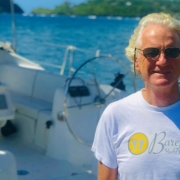3. Rob’s Response: How do Sail Canada cruising courses differ from ASA?
Barefoot Offshore Sailing School is one of the few schools in the world, and the only one in the Caribbean, that offers both ASA and Sail Canada certifications.
Participants in our courses often ask: what’s the difference between Sail Canada courses and American Sailing Association (ASA) courses? Is there an advantage to one system over the other? As a Sail Canada and ASA Advanced and Offshore Instructor, here is my perspective.
Background
Until 2018, BOSS did not offer Sail Canada courses, so all our guests were certified to ASA standards. Now, however, Sail Canada is an option for many of our offerings, and this will continue to expand in future as BOSS increases the number of instructors capable of certifying students in both systems.
Sail Canada and ASA standards are quite similar, for the principal reason that when ASA started up in the 1980s, it licensed the then Canadian Yachting Association standards as the initial basis for the ASA system. While differences have emerged in the 40 years since then, the two systems remain largely parallel.
ASA and Sail Canada Cruising Courses Overview
What are the main differences between the two systems?
The main differences between the two systems arise because Sail Canada, as the national organization for the sport of sailing in Canada, has access to a cadre of volunteers who work on regularly upgrading the standards, and the related exams and learning materials. Senior members in Sail Canada’s instructor community meet monthly to consider and implement updates to the Learn to Cruise system. (Full disclosure: I serve as a member of Sail Canada’s national Training and Certification Advisory Committee that oversees this effort. As a Sail Canada Instructor Evaluator, I contribute to the development of cruising training materials.)
As a result, the Sail Canada requirements are in general somewhat more rigourous than the ASA requirements. For instance:
• Sail Canada has split Coastal Navigation into Basic and Intermediate courses, with Basic Coastal Navigation required as a prerequisite for Intermediate Cruising
• Some content in ASA 106 Advanced is covered earlier in the SC system
• The requirements for Sail Canada Advanced Cruising and Offshore Cruising are both somewhat more extensive than the ASA requirements for the equivalent courses.
Which system should I choose?
When someone asks which system should they choose, my answer is that it depends mainly on where you expect to continue your sailing journey. If you are sailing and taking future courses mainly in the USA, ASA is the better choice. If you are sailing and taking future courses mainly in Canada, then Sail Canada is a better choice.
However, at the end of the day, what matters is that graduates of our courses are proficient, knowledgeable, and safe sailors, and emerge with credentials that are recognized world-wide. This is ultimately a result of hard work by students and their instructors, combined with a great cruising ground like the Grenadines, built on the excellent systems maintained by both organizations. BOSS is proud to accomplish this result under both systems.
Rob McLean is an ASA and Sail Canada Advanced and Offshore Instructor, a Sail Canada Senior Instructor Evaluator, and BOSS Lead Instructor and Coordinator



